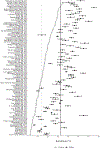Political diversity in U.S. police agencies
- PMID: 40881318
- PMCID: PMC12383486
- DOI: 10.1111/ajps.12945
Political diversity in U.S. police agencies
Abstract
Partisans are divided on policing policy, which may affect officer behavior. We merge rosters from 99 of the 100 largest local U.S. agencies-over one third of local law enforcement agents nationwide-with voter files to study police partisanship. Police skew more Republican than their jurisdictions, with notable exceptions. Using fine-grained data in Chicago and Houston, we compare behavior of Democratic and Republican officers facing common circumstances. We find minimal partisan differences after correcting for multiple comparisons. But consistent with prior work, we find Black and Hispanic officers make fewer stops and arrests in Chicago, and Black officers use force less often in both cities. Comparing same-race partisans, we find White Democrats make more violent crime arrests than White Republicans in Chicago. Our results suggest that despite Republicans' preference for more punitive law enforcement policy and their overrepresentation in policing, partisan divisions often do not translate into detectable differences in on-the-ground enforcement.
Figures








References
-
- Adams IT, McCrain J, Schiff DS, Schiff KJ, and Mourtgos SM. 2024. “Police reform from the top down: Experimental evidence on police executive support for civilian oversight.” Journal of Policy Analysis and Management 51(4): 905–28.
-
- Amoukou Salim I., Nicolas J-B. Brunel, and Tangi Salaün. 2022. “Accurate Shapley Values for Explaining Tree-based Models.” Paper presented at Proceedings of the 25th International Conference on Artificial Intelligence and Statistics (AISTATS) 2022, Valencia, Spain.
-
- Aronow Peter M., and Samii Cyrus. 2016. “Does Regression Produce Representative Estimates of Causal Effects?.” American Journal of Political Science 60(1): 250–67.
-
- Ba Bocar A., Knox Dean, Mummolo Jonathan, and Rivera Roman G.. 2021. “The Role of Officer Race and Gender in Police-Civilian Interactions in Chicago.” Science 371(6530): 696–702. - PubMed
-
- Baumgartner Frank R., Bell Kate, Beyer Luke, Boldrin Tara, Doyle Libby, Govan Lindsey, Halpert Jack, Hicks Jackson, Kyriakoudes Katherine, Lee Cat, et al. 2021. “Intersectional Encounters, Representative Bureaucracy, and the Routine Traffic Stop.” Policy Studies Journal 49(3): 860–86.
Grants and funding
LinkOut - more resources
Full Text Sources
